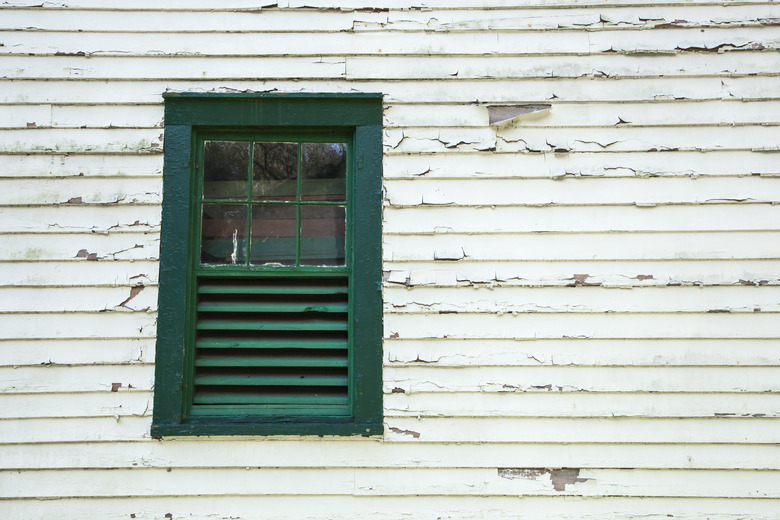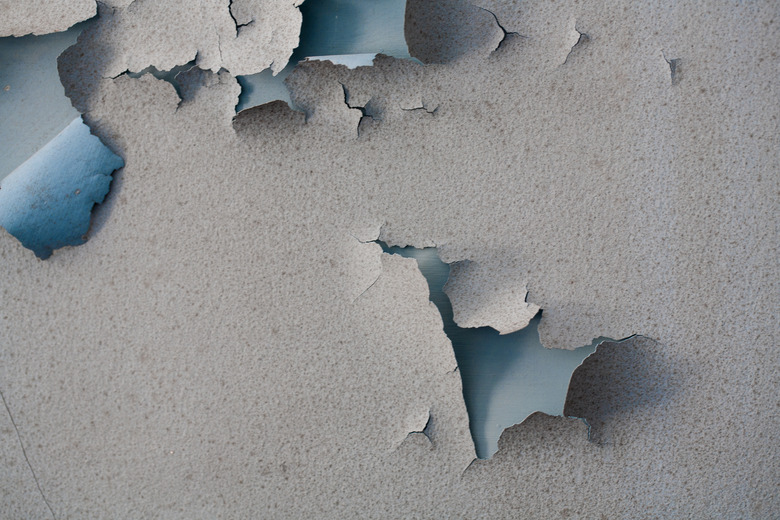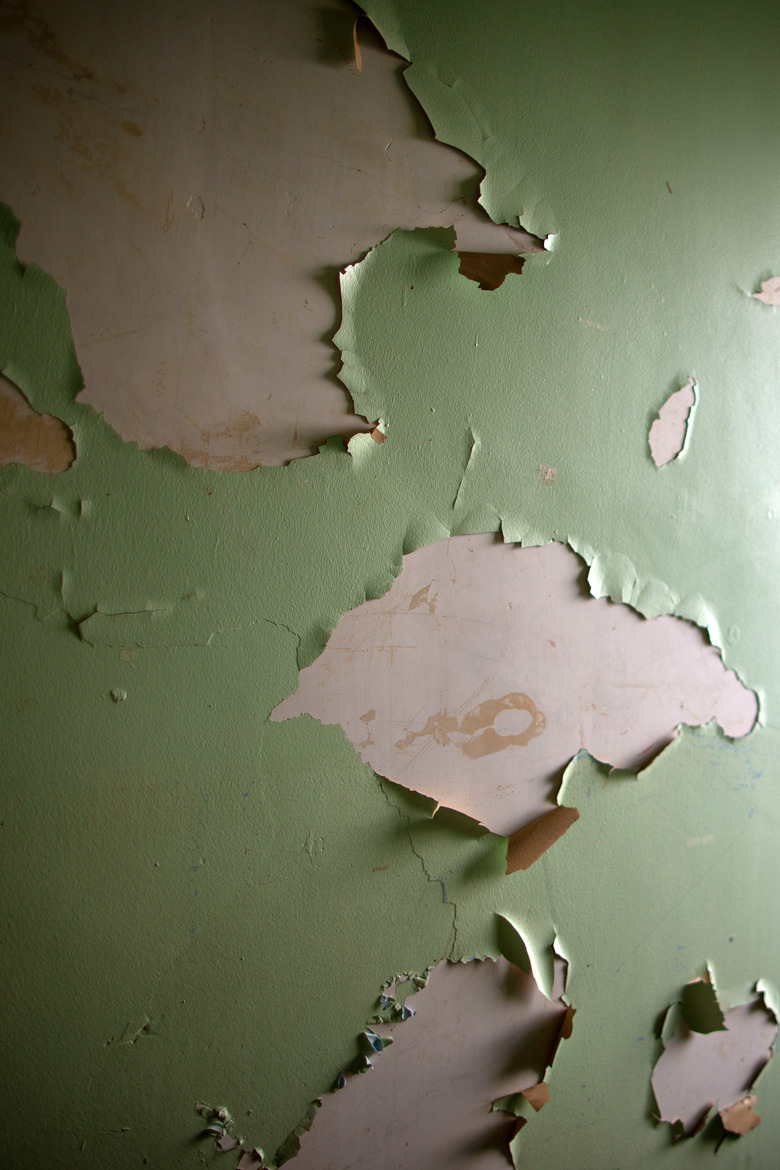Lead Paint Removal: Should You DIY Or Choose A Pro?
We may receive a commission on purchases made from links.
If your home was built before 1978, there's a good chance it contains lead paint — and if the paint is disintegrating, peeling or chipping, it's probably introducing lead to your indoor environment. Lead exposure sometimes cause lead poisoning, especially in young children, who absorb this toxic metal more easily.
In some cases, sealing or encapsulation of the lead paint is enough to prevent it from being an issue, at least for a while. If you prefer to remove the paint rather than sealing it, get ready for loads of extra safety measures to ensure you do the job properly.
Tip
For a small job such as a porch railing or a door, you may be able to handle lead paint removal yourself. A big job, such as an entire home exterior, is best left to a professional who is licensed for lead abatement.
Check With Your County First
Check With Your County First
In cities filled with older homes, lead paint is a known danger. For surfaces such as home exteriors, your county may have specific recommendations for dealing with lead paint. Some even offer a lead-abatement grant for homeowners who meet specific income requirements and have children living in the home. Others loan or offer for rent a suitable type of HEPA (high efficiency particulate air) vacuum.
Visit your county's website for information on the local lead-abatement program and what's available to homeowners. Many such websites feature a list of certified contractors in the area, which could save a lot of time if you decide the job is too large to tackle yourself. If grants or other forms of assistance are available, you'll find the requirements and signup information on such websites.
Common Lead Paint Locations
Common Lead Paint Locations
Home exteriors and old double-hung windows are common locations for old lead-based paint. Wooden porches, porch railings, pillars, trim and doors may also contain lead paint. One key area that frequently houses chipped lead paint is the basement window well, which catches paint flakes chipping off any of the areas surrounding the window. Even sliding the window up or down causes paint to flake off, sometimes unnoticed until the next time you open the window and look into its well.
The soil around a painted older home most likely contains lead from old paint. For this reason, it's best not to let young children play in the dirt immediately surrounding the house. Planting a garden in this soil is also not a good idea. Instead, use containers or raised beds with fresh soil or pick a spot far from any painted structures.
Paint Removal Safety Precautions
Paint Removal Safety Precautions
The most important thing to consider about removing lead paint is to do your best not to create any paint chips, flakes or dust. This means no sanding or scraping of the painted surfaces while they're dry. Anything that can be removed from the work area ahead of time, such as furniture, should be removed so that it doesn't get covered in lead dust. Covering other items that can't easily be moved is the best way to protect those objects. Also cover the floor with thick plastic, such as with tarp, taping it around all edges so no paint particles fall beneath the plastic.
If you are working in a specific room, limit the chances of lead paint particles reaching other areas of the home by blocking off the room with two sheets of 6-milimeter clear plastic taped over the door. Tape the first one completely around the doorway and then create a vertical slit down the middle for entry and exit. The other sheet of plastic goes over the first so it functions like a flap. Tape over air vents and return ducts and turn off central heat or air conditioning as well as ceiling fans.
Dress as if touching the paint or breathing in fumes is dangerous. Wear full clothing coverage and heavy-duty rubber gloves. A respirator with a P-100 filter helps prevent breathing in any lead particles. Also keep a true HEPA wet/dry vacuum on hand, which is designed for such projects. A true HEPA setup filters out particles of 0.3 microns and larger in size, while a standard HEPA filter in a vacuum might only filter out items of 2 microns and larger, which means it leaves behind smaller particles.
How to Remove Lead Paint Yourself
How to Remove Lead Paint Yourself
If there's only a small presence of lead in your home and you're confident you have all the right safety gear, there is a way to remove lead paint yourself. Unsure of whether or not you can handle it, or have more of a problem than you realized? Call an abatement contractor as soon as possible.
- Once everything surrounding the project area is protected from potential contact with lead paint, fill a spray bottle with water and spritz all the lead paint you plan to remove.
- Scrape the wet paint from the top down using a carbide scraper if working on a vertical area.
- Wipe the area regularly with a rag to view your progress and remove bits of lead paint clinging to the surface.
- Rinse the cloth in clean water and wring it out, changing the water as needed. Though it may be tempting to use a torch or heat gun to loosen the paint, this could release toxic fumes from the paint into the air, so don't do it.
- Once you've scraped away as much paint as possible from the area, switch to a medium-grit, damp sanding sponge. A sanding sponge is ideal for curves and detailed areas that are difficult to scrape without harming the wood.
- Wipe down everything with a damp, heavy-duty paper towel, such as the type sold for garage spill cleanup.
- Follow up with a light rinse by dipping a fresh cloth in clean water, wringing it out and then wiping all the scraped and sanded areas.
- Run the HEPA vacuum over every space on which you've worked as well as any place paint may have fallen in the general area.
- Continue carefully cleaning up by spraying water on any areas of the floor plastic that may have paint on them.
- Gently remove the tape from the perimeter of the room and lift the edges of the plastic so any gunk on the sheet moves toward the middle; this ensures the mess doesn't fall off the plastic into the room.
Tip
All of the plastic from the room as well as any paper towels or rags used during the project should be placed in a heavy-duty trash bag, such as a contractor's bag. Contact your local trash collection department to see whether this can be discarded for regular trash pickup or if you need to take it to a special collection site due to potential lead content.
How a Professional Removes Lead Paint
How a Professional Removes Lead Paint
Depending on the size of the project, it's often easier, less expensive and generally safer to encapsulate, or seal off, the old paint. Covering lead paint properly requires a special encapsulating primer or paint in place of other typical house paints, but these are generally not for use on floors, windowsills or other areas where premature wear is likely. Encapsulates only work on lead paint that's still in good shape.
If the contractor plans to remove some of the paint, they'll completely seal off the area if working indoors to prevent lead contamination. They may use a low-temperature heat gun in some instances or power tools fitted with HEPA gear to capture any particles. The contractor should never use power tools without HEPA filtration. Wet sanding, wire brushes and wet scraping are other methods a professional uses to remove lead paint. For easily removable items, such as door and window trim, he may remove the pieces and take them offsite to remove the lead.
In some cases, it may be easier and less expensive to simply replace items, such as the above-window or door trim. If the lead paint is on a material like a plaster interior wall, it's also sometimes less expensive to just cover the area with drywall atop the old wall. This doesn't get rid of or encapsulate the lead, but it keeps it from escaping into the home as long as the new wall remains in place undisturbed.
Finding the Right Contractor
Finding the Right Contractor
If removing lead paint is too big a task to tackle yourself, hire a certified lead-safe renovation, repair and painting, or RRP, contractor. The Environmental Protection Agency (EPA) created the RRP rule, which states that companies repairing, renovating or painting pre-1978 homes must be certified by the EPA or an EPA-approved agency to perform such work if the project involves disturbing lead-based paint. Homeowners are not required to follow this rule when doing such work themselves. In communities with plenty of older wood homes, it should be relatively easy to find contractors with proper certification since this is a common need in the area.
Certified contractors follow approved procedures for removing or encapsulating the paint and perform a thorough cleanup. These details should all be mentioned on the company's website, literature or social media sites. A contractor should also be able to give a free estimate after checking out the scope of the project.
References
- Environmental Protection Agency: Renovation, Repair and Painting Program: Do-It-Yourselfers
- Lakewood Ohio: Lead Safety & Prevention FAQs
- JSE Labs: 5 Essential Dos and Dont's of Painting Over Lead Paint
- New York State Department of Health: Encapsulants: A Technique to Control Lead Paint Hazards
- Zota Pro: How Do Professionals Handle Older Homes With Lead-Based Paint?


